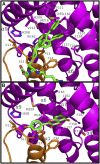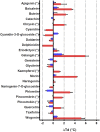Biochemical and Structural Insights on the Poplar Tau Glutathione Transferase GSTU19 and 20 Paralogs Binding Flavonoids
- PMID: 36032685
- PMCID: PMC9412104
- DOI: 10.3389/fmolb.2022.958586
Biochemical and Structural Insights on the Poplar Tau Glutathione Transferase GSTU19 and 20 Paralogs Binding Flavonoids
Abstract
Glutathione transferases (GSTs) constitute a widespread superfamily of enzymes notably involved in xenobiotic detoxification and/or in specialized metabolism. Populus trichocarpa genome (V4.1 assembly, Phytozome 13) consists of 74 genes coding for full-length GSTs and ten likely pseudogenes. These GSTs are divided into 11 classes, in which the tau class (GSTU) is the most abundant with 54 isoforms. PtGSTU19 and 20, two paralogs sharing more than 91% sequence identity (95% of sequence similarity), would have diverged from a common ancestor of P. trichocarpa and P. yatungensis species. These enzymes display the distinctive glutathione (GSH)-conjugation and peroxidase activities against model substrates. The resolution of the crystal structures of these proteins revealed significant structural differences despite their high sequence identity. PtGSTU20 has a well-defined deep pocket in the active site whereas the bottom of this pocket is disordered in PtGSTU19. In a screen of potential ligands, we were able to identify an interaction with flavonoids. Some of them, previously identified in poplar (chrysin, galangin, and pinocembrin), inhibited GSH-conjugation activity of both enzymes with a more pronounced effect on PtGSTU20. The crystal structures of PtGSTU20 complexed with these molecules provide evidence for their potential involvement in flavonoid transport in P. trichocarpa.
Keywords: Populus trichocarpa; flavonoids; glutathione transferase (GST); ligandin property; photosynthetic organisms; poplar; specialized metabolism; structure.
Copyright © 2022 Sylvestre-Gonon, Morette, Viloria, Mathiot, Boutilliat, Favier, Rouhier, Didierjean and Hecker.
Conflict of interest statement
The authors declare that the research was conducted in the absence of any commercial or financial relationships that could be construed as a potential conflict of interest.
Figures




Similar articles
-
The poplar Phi class glutathione transferase: expression, activity and structure of GSTF1.Front Plant Sci. 2014 Dec 23;5:712. doi: 10.3389/fpls.2014.00712. eCollection 2014. Front Plant Sci. 2014. PMID: 25566286 Free PMC article.
-
Functional, Structural and Biochemical Features of Plant Serinyl-Glutathione Transferases.Front Plant Sci. 2019 May 22;10:608. doi: 10.3389/fpls.2019.00608. eCollection 2019. Front Plant Sci. 2019. PMID: 31191562 Free PMC article. Review.
-
Substrate specificities of two tau class glutathione transferases inducible by 2,4,6-trinitrotoluene in poplar.Biochim Biophys Acta. 2015 Sep;1850(9):1877-83. doi: 10.1016/j.bbagen.2015.05.015. Epub 2015 May 27. Biochim Biophys Acta. 2015. PMID: 26026470
-
Human theta class glutathione transferase: the crystal structure reveals a sulfate-binding pocket within a buried active site.Structure. 1998 Mar 15;6(3):309-22. doi: 10.1016/s0969-2126(98)00034-3. Structure. 1998. PMID: 9551553
-
Structure, function and evolution of glutathione transferases: implications for classification of non-mammalian members of an ancient enzyme superfamily.Biochem J. 2001 Nov 15;360(Pt 1):1-16. doi: 10.1042/0264-6021:3600001. Biochem J. 2001. PMID: 11695986 Free PMC article. Review.
Cited by
-
Overlooked and misunderstood: can glutathione conjugates be clues to understanding plant glutathione transferases?Philos Trans R Soc Lond B Biol Sci. 2024 Nov 18;379(1914):20230365. doi: 10.1098/rstb.2023.0365. Epub 2024 Sep 30. Philos Trans R Soc Lond B Biol Sci. 2024. PMID: 39343017 Free PMC article. Review.
-
Biochemical and Structural Characterization of Chi-Class Glutathione Transferases: A Snapshot on the Glutathione Transferase Encoded by sll0067 Gene in the Cyanobacterium Synechocystis sp. Strain PCC 6803.Biomolecules. 2022 Oct 13;12(10):1466. doi: 10.3390/biom12101466. Biomolecules. 2022. PMID: 36291676 Free PMC article.
References
-
- Axarli I., Dhavala P., Papageorgiou A. C., Labrou N. E. (2009b). Crystallographic and Functional Characterization of the Fluorodifen-Inducible Glutathione Transferase from Glycine max Reveals an Active Site Topography Suited for Diphenylether Herbicides and a Novel L-Site. J. Mol. Biol. 385, 984–1002. 10.1016/j.jmb.2008.10.084 - DOI - PubMed
LinkOut - more resources
Full Text Sources
Research Materials

